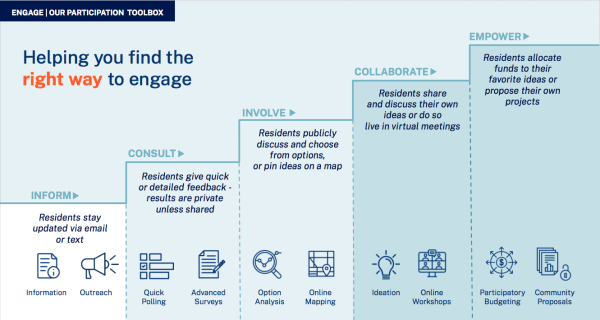Participatory budgeting can be a powerful tool for cities to educate, engage, and empower communities. As one of the methods ranking highest on the participation ladder, this kind of engagement project transfers considerable decision-making power to residents and stakeholders and thus maximizes the many benefits of community engagement. But what does it all entail? And how do you get started?
This blog post is an excerpt from our Beginner’s Guide to Participatory Budgeting. Eager to learn more? Download the full guide.
What is a participatory budget?
Let’s start with a definition of the term. A participatory budget is an innovative policy-making tool that directly involves community members in the allocation of public funds. Local governments ask community members and relevant stakeholders to help them define which social domains, problems or opportunities should receive a share of the city budget, which share of the budget that should be, and which issues or initiatives have the highest urgency. By organizing a participatory budget, cities can tap directly into the collective intelligence of their communities and align the allocation of public money with real-life community needs.
Allowing residents and stakeholders to weigh in on the allocation of public funds requires a significant degree of engagement. That’s why participatory budgeting is one of the highest-ranking engagement methods on the participation ladder. While it requires careful planning and preparation, it also bolsters the legitimacy of your decision-making and the sense of trust community members foster towards their elected representatives.

While the process might seem a tad daunting, it’s really all about having a clear goal, and following clear steps towards that goal. From laying the groundwork to processing input and implementing results, we’ve defined 8 steps to effectively implement a participatory budget in your city or town.
The 8 steps towards an effective participatory budget
- Laying the groundwork. There are critical decisions to be taken in the early stages of a participatory budget, such as your final result or outcome, the metrics you use to assess impact, and the way you will interact with residents.
- Browse through the information available and learn about the theory of participatory budgeting through guides or case studies.
- Decide on the main goal of your project. Besides distributing funds, your participatory budget could aim to educate community members on local topics, create interactions between participants, or gain insights into community members’ most urgent priorities.
- Decide how you want to engage your residents (online, offline or a mix of both).
- Informing participants. To build trust, it’s essential to provide clear, transparent and sufficient information about your project from the get-go. If everyone knows the rules of the game, the whole process is bound to flow a lot more smoothly. Here are some guidelines to keep in mind.
- Communicate the timeframe, process, and rules. When will the community be able to participate? How long will it take you to process the ideas, and when can community members expect results? The CitizenLab platform has a built-in timeline that allows local governments to structure information and break down the process.
- If you’re allowing community members to contribute ideas, it’s important to share clear eligibility criteria for these ideas, such as cost or accessibility.
- Educate community members by proactively sharing important (background) information or recommendations from subject matter experts. If community members are weighing in on the distribution of mobility funds, you could for instance share traffic data or expert opinions on the current situation.
- Manage your community’s expectations by proactively being transparent and honest about the impact their participation will genuinely have on the final decision.
- Collecting community input. Some participatory budgeting projects include an ideation phase, where residents can freely contribute ideas to improve the community.
- Lead participants to the platform. To obtain a maximum number of responses, focus on the widespread communication of your campaign.
- Work with intermediaries (specific associations, religious leaders, syndicates), or other micro-influencers to help expand your reach and lower the threshold for groups that are traditionally underrepresented.
- Once the project is launched, allow community members to vote, comment, and discuss ideas on the platform.
- Process input. Community input should be analyzed by city experts and checked according to the eligibility criteria defined earlier in the process. Select the final proposals and provide relevant feedback to participants.
- Put it to a vote. Depending on the type of participatory budget you’re organizing, allow community members to allocate public funds to several themes or ideas. This could be done according to the principle of communicating vessels (funds you add to one domain, must be taken from another) or a shopping basket system (you can add ideas until you reach the limit of your ‘budget’). Give community members enough time to vote—we’d recommend at least 2 months for large-scale projects.
- Close the feedback loop. Which ideas made the cut? Which domains were given the biggest share of the budget? What are the next steps? It is critical to close the feedback loop by sharing the project’s outcomes with participants, proving the impact of their engagement efforts. This will help build long-term trust and will motivate community members to participate when the next community engagement project comes around.
- Implement the changes. This is where residents get to see how their participation makes a real, tangible impact. Turn dreams into plans and plans into action. Meanwhile, keep your community up to date, so they can see what’s changing.
- Start over. To truly strengthen the democratic fiber of your community, embed participatory budgeting as a permanent part of the policy cycle.
Set up your project
Eager to get started? You’ll find everything there is to know in the following must-reads:






